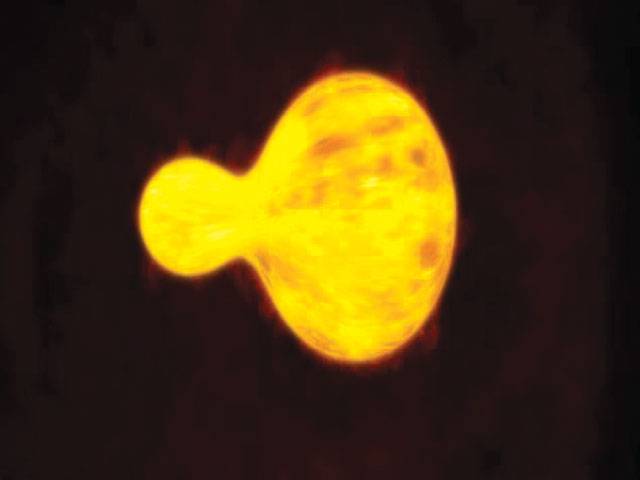CHILE - It is among the largest object ever spotted in the Universe - and has a diameter more than 1300 times that of our Sun.
Dubbed a ‘hypergiant’, the yellow star was part of a unique double double star system, with the second component so close that it is in contact with the main star - making it look rather like a table tennis bat. Astronomers say the find is unique - and could help explain how stars interact. It was spotted by ESO’s Very Large Telescope Interferometer, and is the largest yellow star — and one of the ten largest stars found so far.
Observations spanning over sixty years, some from amateur observers, also indicate that this rare and remarkable object is changing very rapidly and has been caught during a very brief phase of its life.
‘The new observations also showed that this star has a very close binary partner, which was a real surprise,’ says Olivier Chesneau, who led the research.
‘The two stars are so close that they touch and the whole system resembles a gigantic peanut.’
The astronomers made use of a technique called interferometry to combine the light collected from multiple individual telescopes, effectively creating a giant telescope up to 140 metres in size.
The new results prompted the team to thoroughly investigate older observations of the star spanning more than sixty years, to see how it had behaved in the past.
Yellow hypergiants are very rare, with only a dozen or so known in our galaxy — the best-known example being Rho Cassiopeiae. They are among the biggest and brightest stars known and are at a stage of their lives when they are unstable and changing rapidly. Due to this instability, yellow hypergiants also expel material outwards, forming a large, extended atmosphere around the star.
Despite its great distance of nearly 12 000 light-years from Earth, the object can just about be seen with the naked eye by the keen-sighted. HR 5171 A has been found to be getting bigger over the last 40 years, cooling as it grows, and its evolution has now been caught in action.
Only a few stars are caught in this very brief phase, where they undergo a dramatic change in temperature as they rapidly evolve.
By analysing data on the star’s varying brightness, using observations from other observatories, the astronomers confirmed the object to be an eclipsing binary system where the smaller component passes in front and behind the larger one as it orbits.
In this case HR 5171 A is orbited by its companion star every 1300 days.
Thursday, April 18, 2024
Megastar, 1,300 times the size of Sun spotted

Caption: Megastar, 1,300 times the size of Sun spotted
Mayor stresses beautification of Sukkur’s roads
April 18, 2024
President Zardari to address joint session of Parliament today
10:15 AM | April 18, 2024
Pakistan set to face New Zealand in first T20I match today
10:12 AM | April 18, 2024
World's largest Chinese telescope spots over 900 rotating neutron stars
10:06 AM | April 18, 2024
Rail Revival
April 17, 2024
Addressing Climate Change
April 17, 2024
Saudi Investment
April 17, 2024
Political Reconciliation
April 16, 2024
Pricing Pressures
April 16, 2024
Justice denied
April 18, 2024
AI dilemmas unveiled
April 18, 2024
Tax tangle
April 18, 2024
Workforce inequality
April 17, 2024
New partnerships
April 17, 2024
ePaper - Nawaiwaqt
Advertisement
Nawaiwaqt Group | Copyright © 2024





